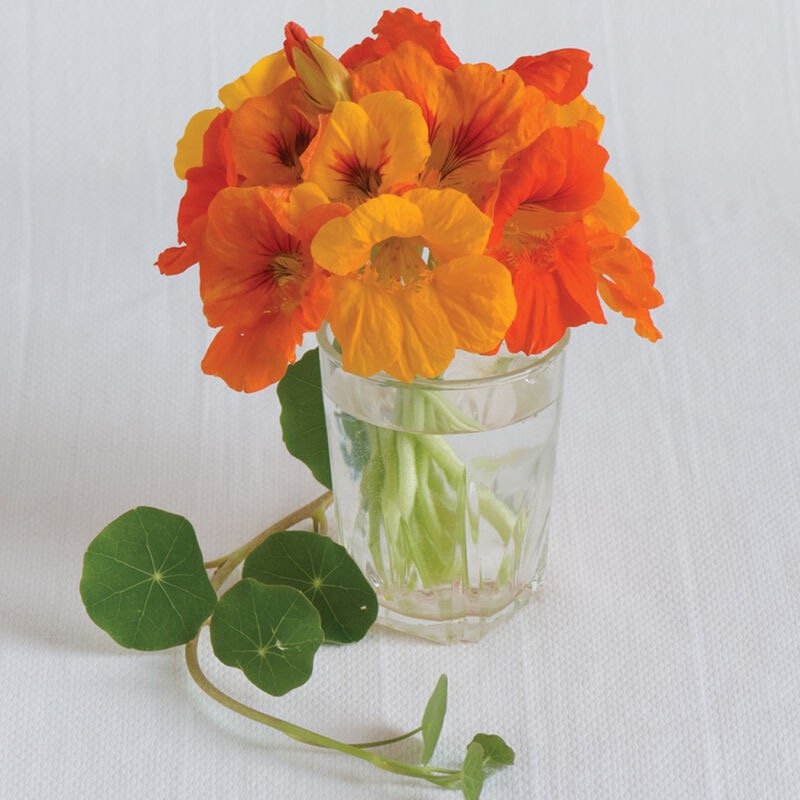Trailing Nasturtium Mix Flower Seed
DAYS TO GERMINATION:
7-14 days at 60-65°F (16-18°C)
SOWING:
Direct seed (recommended) - Sow 1/2-1" deep. Transplant - Sow 3-4 weeks before planting out. Cover seeds as darkness is required for germination.
LIGHT PREFERENCE:
Sun/Part Shade.
PLANT HEIGHT:
Varies. Trellising is useful for climbing/trailing varieties as they will need support to climb.
PLANT SPACING:
8-12". Thin to 3-5 plants in hanging baskets or 10" containers.
HARDINESS ZONES:
Annual.
HARVEST:
Edible flowers - fully open; Edible leaves - at any time.
SOIL REQUIREMENTS:
Well-drained, but not especially rich soil. High nitrogen levels promote more foliage than flower production.
USES:
Bedding plant. Excellent in containers and hanging baskets. Edible flowers, leaves and seed pods.
SCIENTIFIC NAME:
Tropaeolum spp.
ALTERNATE NAMES:
Garden nasturtium, Indian cress
Perfect for hanging baskets and containers, or even as a ground cover.
Flowers in red, rose, orange, and yellow. Perfect for hanging baskets and containers, or even as a ground cover. Will "climb" if tied to upright supports. Also known as garden nasturtium and Indian cress.
Edible Flower: Use the flowers as garnishes, or stuff with soft cheese. The flowers can be minced and added to butters and the immature seed heads can be pickled. Nasturtiums are a popular choice for adding color to salad mix. Peppery-flavored foliage is also edible.
DAYS TO GERMINATION:
7-14 days at 60-65°F (16-18°C)
SOWING:
Direct seed (recommended) - Sow 1/2-1" deep. Transplant - Sow 3-4 weeks before planting out. Cover seeds as darkness is required for germination.
LIGHT PREFERENCE:
Sun/Part Shade.
PLANT HEIGHT:
Varies. Trellising is useful for climbing/trailing varieties as they will need support to climb.
PLANT SPACING:
8-12". Thin to 3-5 plants in hanging baskets or 10" containers.
HARDINESS ZONES:
Annual.
HARVEST:
Edible flowers - fully open; Edible leaves - at any time.
SOIL REQUIREMENTS:
Well-drained, but not especially rich soil. High nitrogen levels promote more foliage than flower production.
USES:
Bedding plant. Excellent in containers and hanging baskets. Edible flowers, leaves and seed pods.
SCIENTIFIC NAME:
Tropaeolum spp.
ALTERNATE NAMES:
Garden nasturtium, Indian cress
Perfect for hanging baskets and containers, or even as a ground cover.
Flowers in red, rose, orange, and yellow. Perfect for hanging baskets and containers, or even as a ground cover. Will "climb" if tied to upright supports. Also known as garden nasturtium and Indian cress.
Edible Flower: Use the flowers as garnishes, or stuff with soft cheese. The flowers can be minced and added to butters and the immature seed heads can be pickled. Nasturtiums are a popular choice for adding color to salad mix. Peppery-flavored foliage is also edible.
DAYS TO GERMINATION:
7-14 days at 60-65°F (16-18°C)
SOWING:
Direct seed (recommended) - Sow 1/2-1" deep. Transplant - Sow 3-4 weeks before planting out. Cover seeds as darkness is required for germination.
LIGHT PREFERENCE:
Sun/Part Shade.
PLANT HEIGHT:
Varies. Trellising is useful for climbing/trailing varieties as they will need support to climb.
PLANT SPACING:
8-12". Thin to 3-5 plants in hanging baskets or 10" containers.
HARDINESS ZONES:
Annual.
HARVEST:
Edible flowers - fully open; Edible leaves - at any time.
SOIL REQUIREMENTS:
Well-drained, but not especially rich soil. High nitrogen levels promote more foliage than flower production.
USES:
Bedding plant. Excellent in containers and hanging baskets. Edible flowers, leaves and seed pods.
SCIENTIFIC NAME:
Tropaeolum spp.
ALTERNATE NAMES:
Garden nasturtium, Indian cress
Perfect for hanging baskets and containers, or even as a ground cover.
Flowers in red, rose, orange, and yellow. Perfect for hanging baskets and containers, or even as a ground cover. Will "climb" if tied to upright supports. Also known as garden nasturtium and Indian cress.
Edible Flower: Use the flowers as garnishes, or stuff with soft cheese. The flowers can be minced and added to butters and the immature seed heads can be pickled. Nasturtiums are a popular choice for adding color to salad mix. Peppery-flavored foliage is also edible.

